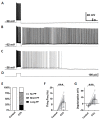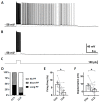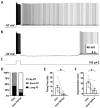Involvement of TRPC4 and 5 Channels in Persistent Firing in Hippocampal CA1 Pyramidal Cells
- PMID: 32033274
- PMCID: PMC7072216
- DOI: 10.3390/cells9020365
Involvement of TRPC4 and 5 Channels in Persistent Firing in Hippocampal CA1 Pyramidal Cells
Abstract
Persistent neural activity has been observed in vivo during working memory tasks, and supports short-term (up to tens of seconds) retention of information. While synaptic and intrinsic cellular mechanisms of persistent firing have been proposed, underlying cellular mechanisms are not yet fully understood. In vitro experiments have shown that individual neurons in the hippocampus and other working memory related areas support persistent firing through intrinsic cellular mechanisms that involve the transient receptor potential canonical (TRPC) channels. Recent behavioral studies demonstrating the involvement of TRPC channels on working memory make the hypothesis that TRPC driven persistent firing supports working memory a very attractive one. However, this view has been challenged by recent findings that persistent firing in vitro is unchanged in TRPC knock out (KO) mice. To assess the involvement of TRPC channels further, we tested novel and highly specific TRPC channel blockers in cholinergically induced persistent firing in mice CA1 pyramidal cells for the first time. The application of the TRPC4 blocker ML204, TRPC5 blocker clemizole hydrochloride, and TRPC4 and 5 blocker Pico145, all significantly inhibited persistent firing. In addition, intracellular application of TRPC4 and TRPC5 antibodies significantly reduced persistent firing. Taken together these results indicate that TRPC4 and 5 channels support persistent firing in CA1 pyramidal neurons. Finally, we discuss possible scenarios causing these controversial observations on the role of TRPC channels in persistent firing.
Keywords: TRPC antagonists; TRPC channels; cholinergic modulation; hippocampus; intrinsic persistent activity; patch clamp; working memory.
Conflict of interest statement
The authors declare no conflict of interest.
Figures








Similar articles
-
TRPC channels underlie cholinergic plateau potentials and persistent activity in entorhinal cortex.Hippocampus. 2011 Apr;21(4):386-97. doi: 10.1002/hipo.20755. Hippocampus. 2011. PMID: 20082292
-
Switching between persistent firing and depolarization block in individual rat CA1 pyramidal neurons.Hippocampus. 2019 Sep;29(9):817-835. doi: 10.1002/hipo.23078. Epub 2019 Feb 22. Hippocampus. 2019. PMID: 30794330
-
Plasma membrane insertion of TRPC5 channels contributes to the cholinergic plateau potential in hippocampal CA1 pyramidal neurons.Hippocampus. 2011 Sep;21(9):958-67. doi: 10.1002/hipo.20807. Epub 2010 Jun 1. Hippocampus. 2011. PMID: 20865744
-
Do TRPC channels support working memory? Comparing modulations of TRPC channels and working memory through G-protein coupled receptors and neuromodulators.Behav Brain Res. 2018 Nov 15;354:64-83. doi: 10.1016/j.bbr.2018.02.042. Epub 2018 Mar 1. Behav Brain Res. 2018. PMID: 29501506 Review.
-
TRPC1 as a negative regulator for TRPC4 and TRPC5 channels.Pflugers Arch. 2019 Aug;471(8):1045-1053. doi: 10.1007/s00424-019-02289-w. Epub 2019 Jun 20. Pflugers Arch. 2019. PMID: 31222490 Review.
Cited by
-
Transient Receptor Potential Canonical Channels in Health and Disease: A 2020 Update.Cells. 2021 Feb 25;10(3):496. doi: 10.3390/cells10030496. Cells. 2021. PMID: 33668918 Free PMC article.
-
Estradiol elicits distinct firing patterns in arcuate nucleus kisspeptin neurons of females through altering ion channel conductances.Elife. 2024 Dec 13;13:RP96691. doi: 10.7554/eLife.96691. Elife. 2024. PMID: 39671233 Free PMC article.
-
Nonselective TRPC channel inhibition and suppression of aminoglycoside-induced premature termination codon readthrough by the small molecule AC1903.J Biol Chem. 2022 Feb;298(2):101546. doi: 10.1016/j.jbc.2021.101546. Epub 2022 Jan 6. J Biol Chem. 2022. PMID: 34999117 Free PMC article.
-
Noradrenergic Suppression of Persistent Firing in Hippocampal CA1 Pyramidal Cells through cAMP-PKA Pathway.eNeuro. 2021 Mar 22;8(2):ENEURO.0440-20.2020. doi: 10.1523/ENEURO.0440-20.2020. Print 2021 Mar-Apr. eNeuro. 2021. PMID: 33637539 Free PMC article.
-
Estradiol elicits distinct firing patterns in arcuate nucleus kisspeptin neurons of females through altering ion channel conductances.bioRxiv [Preprint]. 2024 Sep 3:2024.02.20.581121. doi: 10.1101/2024.02.20.581121. bioRxiv. 2024. Update in: Elife. 2024 Dec 13;13:RP96691. doi: 10.7554/eLife.96691. PMID: 38915596 Free PMC article. Updated. Preprint.
References
Publication types
MeSH terms
Substances
LinkOut - more resources
Full Text Sources
Research Materials
Miscellaneous

